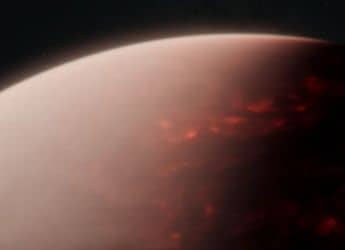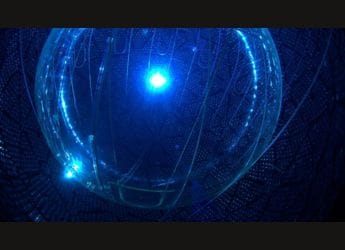- Home
- Science
- Science News
- Darkest Regions of the Moon Explored Using Machine Learning Ahead of NASA’s Artemis Mission
Darkest Regions of the Moon Explored Using Machine Learning Ahead of NASA’s Artemis Mission
Researchers used a deep learning-driven post-processing tool to explore the darkest areas of the Moon.

Photo Credit: ETH Zurich/LPI
A view of the lunar south pole with two of NASA's Artemis landing sites
The Moon has specific areas that never receive sunlight, regions that are located in areas of 'permanent shadow'. These dark regions include the sunken floors of impact craters that remain shadowed and are extremely cold. Scientists believe that these sites, devoid of sunlight, might prove to be fruitful if explored — due to the possibility of formation of ice. However, the darkness of these areas made exploration a challenging process. An international team of scientists has now developed a method to peer into the darkest areas on the lunar surface, ahead of NASA's upcoming Artemis mission.
The permanently dark regions witness temperatures less than 100 degrees Kelvin (-173 degrees Celsius) and approaching absolute zero, where water and other volatile substances may get frozen in the soil. The ice formed in the area might provide clues to the integration of water in the Earth-Moon system, according to researchers at ETH Zurich. In addition, the ice may also offer resources that could be used by astronauts for consumption, rocket propellant, or radiation shielding.
To explore these areas, the team used a physics-based deep learning-driven post-processing tool to produce high-signal and high-resolution Lunar Reconnaissance Orbiter (LRO) Narrow Angle Camera images of 44 shadowed regions in the Artemis exploration zone. This tool is efficient in capturing photons that are bounced into the dark regions from crater walls and adjacent mountains. This method allows scientists to reveal potential exploration regions in images.
“Visible routes into the permanently shadowed regions can now be designed, greatly reducing risks to Artemis astronauts and robotic explorers,” explained principal scientist Dr David A. Kring from the Lunar and Planetary Institute (LPI).
According to researchers, astronauts of NASA's Artemis mission will be able to spend only 2 hours in the shadowed regions wearing the spacesuit designed for them. The new images will help mission planners to guide the astronauts to boulders in the dark regions and locations where the soil can be analysed for the distribution of any ices.
The team applied their technique on images gathered by the Lunar Reconnaissance Orbiter Camera, which has been used to document the Artemis exploration zone. The enhanced images were analysed to determine that water ice was not visible in the sheets that cover the dark Lunar regions.
“There is no evidence of pure surface ice within the shadowed areas, implying that any ice must be mixed with lunar soil,” said Dr Valentin Bickel, a former graduate student intern at the Lunar and Planetary Institute (LPI) and now a postdoctoral researcher at ETH Zurich. Dr Bickel is also the lead author of the study published in Geophysical Research Letters.
Dr Bickel added that their findings might also impact the mission delivering the PRIME-1 payload of NASA. He said that they have detected a crater and some other features that can alter the location where the “Intuitive Machines' hopper touches down later this year.”
Get your daily dose of tech news, reviews, and insights, in under 80 characters on Gadgets 360 Turbo. Connect with fellow tech lovers on our Forum. Follow us on X, Facebook, WhatsApp, Threads and Google News for instant updates. Catch all the action on our YouTube channel.
Related Stories
- Samsung Galaxy Unpacked 2025
- ChatGPT
- Redmi Note 14 Pro+
- iPhone 16
- Apple Vision Pro
- Oneplus 12
- OnePlus Nord CE 3 Lite 5G
- iPhone 13
- Xiaomi 14 Pro
- Oppo Find N3
- Tecno Spark Go (2023)
- Realme V30
- Best Phones Under 25000
- Samsung Galaxy S24 Series
- Cryptocurrency
- iQoo 12
- Samsung Galaxy S24 Ultra
- Giottus
- Samsung Galaxy Z Flip 5
- Apple 'Scary Fast'
- Housefull 5
- GoPro Hero 12 Black Review
- Invincible Season 2
- JioGlass
- HD Ready TV
- Laptop Under 50000
- Smartwatch Under 10000
- Latest Mobile Phones
- Compare Phones
- Redmi Note 15 5G
- Redmi Note 15 Pro 5G
- Redmi Note 15 Pro+ 5G
- Lava Play Max
- Poco C85 5G
- Honor Magic 8 Lite
- Jolla Phone
- Realme P4x 5G
- Asus ProArt P16
- MacBook Pro 14-inch (M5, 2025)
- OnePlus Pad Go 2
- Poco Pad M1
- Just Corseca Skywatch Pro
- Honor Watch X5
- Acerpure Nitro Z Series 100-inch QLED TV
- Samsung 43 Inch LED Ultra HD (4K) Smart TV (UA43UE81AFULXL)
- Asus ROG Ally
- Nintendo Switch Lite
- Haier 1.6 Ton 5 Star Inverter Split AC (HSU19G-MZAID5BN-INV)
- Haier 1.6 Ton 5 Star Inverter Split AC (HSU19G-MZAIM5BN-INV)

















